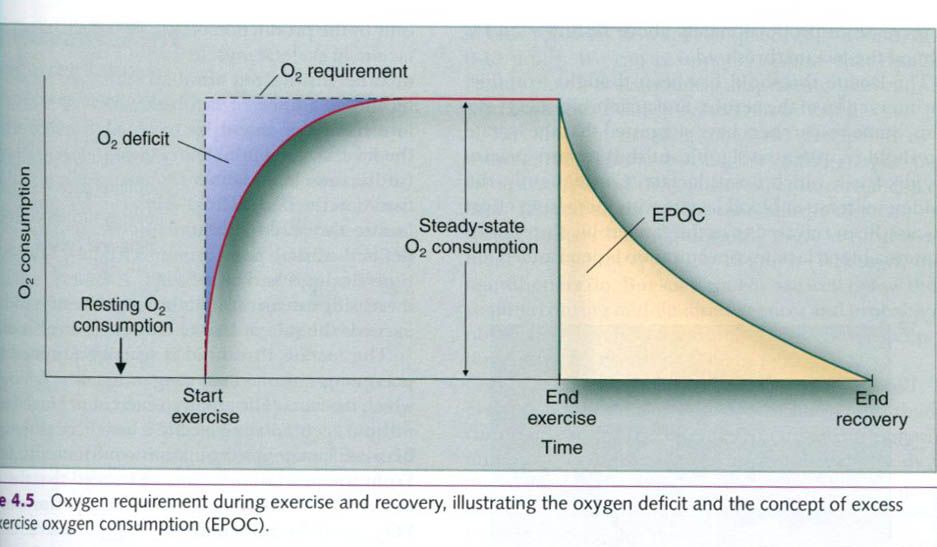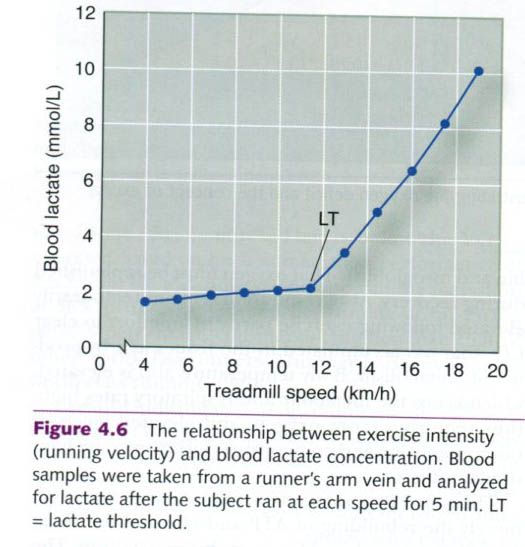Postexercise oxygen consumption
The matching of energy requirements during
exercise with oxygen delivery is not perfect. When aerobic exercise begins, the
oxygen transport system(respiration and circulation) does not immediately
supply the needed quantity of oxygen to the active muscle. Oxygen consumption
requires several minutes to reach the required(steady state) level at which the
aerobic processes are fully functional, even though the body’s oxygen
requirements increase the moment exercise begins.
Because oxygen needs and oxygen supply differ
during the transition from rest to exercise, the body incurs an oxygen deficit,
as shown in the figure below. The deficit occurs even at low exercise
intensities. The oxygen deficit is
calculated simply as the difference between the oxygen required for a given
exercise intensity(steady state) and the actual oxygen consumption.
Despite the insufficient oxygen delivery at the onset of exercise, the active
muscles are able to generate the ATP needed through anaerobic pathways.
During the initial minutes of recovery, even
though muscle activity has stopped, oxygen consumption does not immediately
decrease. Rather, oxygen consumption remains temporarily elevated. This
consumption, which exceeds that usually required at rest, traditionally has been
referred to as the “oxygen debt”. The more common term today is excess postexercise oxygen
consumption(EPOC). The EPOC is the volume of oxygen consumed above that
normally consumed at rest. Everyone has experienced this phenomenon at the
end of an intense exercise bout: A fast climb up several flights of stairs
leaves one with a rapid pulse and breathing hard. These physiological
adjustments are serving to support the EPOC. After several minutes of recovery,
the pulse and breathing return to resting rates.
For many years, the EPOC curve was described as
having two distinct components: an
initial fast component and a secondary slow component. According to
classical theory, the fast component of the curve represented the oxygen
required to rebuild the ATP and phosphocreatine(PCr) used during exercise,
especially in its initial stages. Without sufficient oxygen, the high-energy
phosphate bonds in these compounds were broken to supply the required energy.
During recovery, these bonds would need to be re-formed, via oxidative
processes, to replenish the energy stores, or repay the debt. The slow
component of the curve was thought to result from removal of accumulated
lactate from the tissues, by either conversion to glycogen or oxidation to CO2 and H2O, thus providing
the energy needed to restore glycogen
stores.
According to this theory, both the fast and
slow components of the curve reflected the anaerobic activity that had occurred
during exercise. The belief was that by examining the postexercise oxygen
consumption, one could estimate the amount of anaerobic activity that had
occurred.
However, more recently researchers have
concluded that the classical explanation of EPOC is too simplistic. For
example, during the initial phase of exercise, some oxygen is borrowed from the
oxygen stores(hemoglobin and myoglobin). That oxygen must be replenished during
recovery. Also, respiration remains temporarily elevated following exercise
partly in an effort to clear CO2 that has accumulated in the tissues
as a by-product of metabolism. Body temperature also is elevated, which keeps
the metabolic and respiratory rates high, thus requiring more oxygen; and
elevated levels of norepinephrine and epinephrine during exercise have similar effects.
Thus, the EPOC depends on many factors other
than merely the rebuilding of ATP and PCr and the clearing of lactate produced
by anaerobic metabolism. The physiological mechanisms responsible for the EPOC
are not yet clearly defined.
Lactate threshold
Many investigators consider the lactate
threshold to be a good indicator of an athlete’s potential for endurance
exercise. The lactate threshold is defined as the point at which blood
lactate begins to accumulate substantially above resting concentrations during
exercise of increasing intensity. For example, a runner might be
required to run on the treadmill at different speeds with a rest between each
speed. After each run, a blood sample is taken from his or her fingertip, or
from a catheter in one of the arm veins, from which blood lactate is measured.
As illustrated in the picture below, the results of such testing can be used to
plot the relationship between blood
lactate and running velocity. At low running velocities, blood lactate
concentrations remain at or near resting levels. But as running speed
increases, the blood lactate concentration increases rapidly beyond some
threshold velocity. The point at which blood lactate appears to increase
disproportionately above resting values is termed the lactate threshold.
The lactate threshold has been thought to
reflect the interaction of the aerobic and anaerobic energy systems. Some
researchers have suggested that the lactate threshold represents a significant
shift toward anaerobic glycolysis, which forms lactate. Consequently, the sudden increase in blood lactate with
increasing effort has also been referred to as the “anaerobic threshold”.
However, blood lactate concentration is determined not only by the
production of lactate in skeletal muscle or other tissues but also by the clearance
of lactate from the blood by the liver, skeletal muscle, cardiac muscle, and
other tissues in the body. Thus, lactate
threshold is best defined as that point in time during exercise of increasing
intensity when the rate of lactate production exceeds the rate of lactate
clearance or removal.
The lactate threshold is usually expressed as the percentage of maximal oxygen uptake(
% VO2max) at which it occurs. The ability to exercise at a high
intensity without accumulating lactate is beneficial to the athlete because
lactate accumulation contributes to fatique. Major determinants of successful
endurance performance are VO2max
and the percentage of VO2max that an athlete can maintain
for a prolonged period. The latter is probably related to the lactate threshold,
because the the lactate threshold is likely the major determinant of the pace
that can be tolerated during a long-term endurance event. So the ability to
perform at a higher percentage of VO2max probably reflects a higher
lactate threshold. Consequently, a lactate threshold of 80% VO2max
suggests a greater aerobic exercise tolerance than a threshold at 60% VO2max.
Generally, in two individuals with the same maximal oxygen uptake, the
person with the highest lactate threshold exhibits the best endurance
performance, although other factors contribute as well.











0 коментара:
Постави коментар